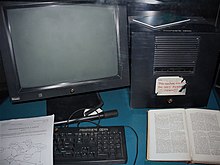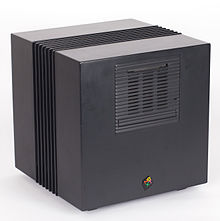NeXTcube
The NeXT computer from 1988 and its very similar successor NeXTcube were high-end workstations from NeXT , which were built from 1988 to 1993. NeXTStep , a specially developed Unix derivative that later formed the basis for Mac OS X , was used as the operating system . The computers were in a cubic (Engl. Cube supplied housing with "one-foot" (305 mm) edge length) made of cast magnesium was, and cost initially about 6,500 US dollars (equivalent to inflation-adjusted approximately 14,019 $ or current 2,020 11,766 €).
The computers represented milestones in terms of the performance of the hardware, their extensive equipment, as well as the sophistication and user-friendliness of the operating system. However, this was reflected in the high price, which made the devices practically unaffordable for private users and students.
Today the NeXT computers are best known for the fact that Tim Berners-Lee developed the World Wide Web and the first web browser on a NeXTcube at the CERN research center. In this context, he also developed and operated the world's first web server on a NeXTCube.
hardware

The built-in magneto-optical drive instead of a hard drive was unique , although the latter was available as an option. The workstation came with a 17 ″ grayscale monitor with 1120 × 832 pixels with built-in speakers.
A Motorola 68030 with a 68882 Co processor for faster mathematical calculations was installed as the CPU . There was also a 56001 digital signal processor (DSP) for multimedia and two special 6-channel DMA controllers that relieved the CPU of input / output processes.
The mouse was connected to the keyboard, which in turn was connected to the monitor. The on / off switch was integrated in the keyboard so that it could only be operated with the original peripherals, unless a special adapter box was used to which a VGA monitor and the original keyboard and mouse could be connected.
Revisions
In 1990 a modified model called NeXTcube was released. It had a 25 MHz 68040 processor, a hard disk instead of the MO drive that was previously used, and a floppy disk drive. A 33 MHz NeXTcube Turbo came later.
NeXT also brought the NeXT dimension for the NeXTcube, a circuit board extension based on the Intel i860 processor. This could z. B. a 32-bit PostScript color monitor can be connected.
Others
The NeXT Computer and NeXTcube were not a great commercial success, partly because of their high prices. Because of their unusual designs, which came from frog design , which also works for Apple , some of them are exhibited in museums of modern art, such as the New Collection of the Pinakothek der Moderne in Munich and the Museum of Modern Art in San Francisco .
See also
Web links
- NeXT Computer Brochure
- BYTE Preview of the NeXT computer
- NeXTarchive (English)
- old-computers.com - NeXTcube (English)
- NeXTComputers.org (English)
